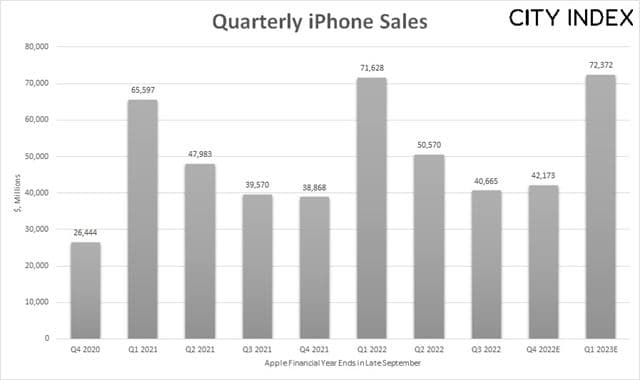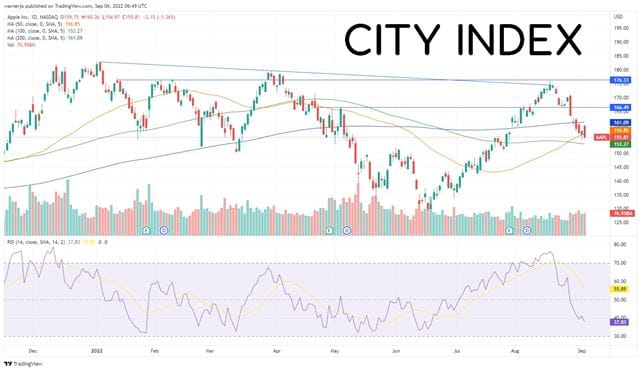
When is the Apple iPhone 14 release date?
Apple is expected to launch and unveil the new iPhone 14 on September 7. It could begin taking pre-orders as soon as September 9 before the new model officially goes on sales on September 16, according to media reports.
That will mark the earliest launch date since 2016 as iPhones have mostly been released in the back-half of September in recent years.
Apple iPhone 14 preview
Apple is known for keeping its cards close to its chest and aims to surprise consumers when it launches the latest version of the iPhone each year, but that only fuels speculation. Expectations are fairly muted this year as Apple and others find it increasingly difficult to deliver a significant upgrade, with only a few muted tweaks forecast to be made from the iPhone 13.
The look and style of the iPhone 14 is expected to remain similar to the latest model. Reports suggest the mini version boasting a 5.4-inch screen could be shelved and replaced by a model with a 6.7-inch screen. The Pro version is also expected to get some extra screen room thanks to a rejig of the front camera (or ‘notch’), a larger and significantly improved main camera, and be equipped with a faster A16 processor (although the standard version is expected to keep the A15). It is worth noting that the new iPhone is set to be powered by Qualcomm’s Snapdragon X65 modem.
There are also rumours that Apple could unveil improvements in battery life, data storage capacity, faster 6E connectivity, a redesigned speaker and titanium frames in a new selection of colours.
The new model may allow users to make satellite calls when normal services are unavailable. Ming-Chi Kou, an analyst at TF International Securities, said Apple has been testing satellite functionality and that Globalstar was the operator ‘most likely’ to partner the iPhone maker. The analyst said this was a possibility last year but was left disappointed when the iPhone 13 came with no satellite connectivity. However, the graphic used to promote the upcoming event shows the Apple logo drawn out using stars in the night sky, raising hopes that this could be the year it happens.
Charging could also be an area of interest as it is highly likely that changes are on the way considering Apple is interested in wireless charging and new regulatory rules in Europe are set to force smartphones to use a common charger over the coming years – but it is unclear whether 2022 will be the year Apple makes its move.
iPhone 14 price: How much will the new iPhone 14 cost?
Apple is expected to maintain the price of the iPhone 14 at $799 while the iPhone 14 Max is expected to be priced at $899. The iPhone 14 Pro, which is anticipated to get more upgrades this time around, will see its price increased by around $100 to $1,099, with the iPhone 14 Pro Max starting at $1,199.
New features help Apple steadily lift the price of its iPhones, but it is also grappling with higher component costs and the inflationary environment, which has pushed up the cost of everything from wages to transportation.
With that in mind, Apple will be treading carefully considering consumers could be more sensitive to pricing than in previous years as they are forced to stretch their budgets and must spend more of their wages on essentials. CEO Tim Cook said back in July that consumers still want to upgrade considering 5G penetration remains low. Pricing could remain key to maintaining growth in iPhone sales should demand be weaker than in previous years.
We have already had some warnings that demand for smartphones and other hardware such as gaming consoles and PCs could be waning following the explosion in demand or tech during the pandemic. For example, memory chipmaker Micron Technology, which supplies Apple and an array of other hardware manufacturers, recently warned it expected smartphone sales to be materially lower than originally forecast in 2022.
However, we also know that Apple has been gaining market share over Android rivals, raising the question of whether this slowdown will hit Apple or if it can outperform and continue to poach customers. International Data Corp recently said it believes global smartphone shipments will fall around 6% in 2022, driven by weaker demand in China, but said Apple shipments should remain positive in 2022. Meanwhile, the largest consumer electronics retailer in the US, Best Buy, reported results last month and said consumers were trading down to cheaper brands for things such as televisions, but not switching to cheaper smartphones despite rampant inflation. That has installed confidence that demand for the new iPhone will hold up in the current environment.
How important is the iPhone to Apple?
The iPhone is Apple’s best-selling product and generated 52% of its revenue in the last financial year and that is expected to stay flat in the current one. Apple is still reliant on the iPhone, but its share of the sales mix has fallen from over 60% between 2015 and 2018 after the company diversified itself by launching new products such as wearables and making a bigger push into services through the likes of its App store and subscription offerings.
The iPhone is also key to Apple’s ecosystem as this acts as the key portal to the array of other products on offer. They encourage people to purchase accessories such as AirPods, tap-into its array of digital services and are more likely to buy other forms of Apple hardware to keep their accounts and systems synced.
Will the iPhone 14 provide a new catalyst for Apple?
With the iPhone key to Apple’s growth, investors will be hoping that the latest model will be able to entice users to upgrade and provide a new catalyst for growth in a tough environment. However, expectations remain muted at present considering the limited scope for any major upgrades to the iPhone 14 and the economic challenges being faced in key markets like Europe and China which, together, account for around 43% of Apple’s revenue.
Analysis by JPMorgan said iPhone 13 sales were better than anticipated during July as fewer people than expected delayed upgrading to wait for the new model, demonstrating that consumers do not expect any major surprises when the iPhone 14 is released.
Apple releases the iPhone in September so it can have it ready for the key holiday shopping season. Sales of iPhones are highly seasonal and over one-third of iPhone sales in the current financial year are thought to have occurred in the first quarter covering the last three months of the calendar year.
Below is a table outlining iPhone sales by each financial quarter over the last two years, demonstrating how the launch of a new iPhone in the fourth quarter leads to a significant jump in sales in the first. It also includes forecasts for iPhone sales for the current and next quarter to show that analysts expect tepid year-on-year growth:

(Source: Company Reports, Bloomberg)
Analysts from Bloomberg Intelligence said it expects iPhone volumes to remain flat in the 2023 financial year but forecasts a 2% rise in sales revenue thanks to the lift in average selling prices. Their estimates suggest that Apple can grow overall revenue of around 4% in the next financial year once its faster-growing services division and other hardware sales are taken into account.
Notably, some are already looking to September 2023 and the launch of the next model, with analysts forecasting a more significant makeover that could grow annual iPhone sales at a much more rapid rate of 7% to 9%.
Where will the iPhone 14 be produced?
Apple has not been immune to the widely reported supply chain problems that have plagued companies around the world this year, having lost billions in sales due to a shortage of parts alone, but it has so far proven more resilient than most.
Many of Apple’s problems this year have spawned from China, where the country’s zero-tolerant approach to Covid-19 plunged the nation back into lockdown and caused significant disruption to the world’s manufacturing hub. There are numerous countries involved in the production of iPhones, but China remains at the heart.
The Covid-19 troubles, twinned with rising tensions between the US and China, is thought to have prompted Apple to take action to mitigate the growing risks to its production line. Reports suggest India is set to play a much bigger role in producing the new iPhone 14 as Apple looks to expand output in other countries to make it less reliant on China. We have already seen some production of other products like the Apple Watch and MacBook shifted to other countries such as Vietnam.
One of Apple’s largest suppliers, Taiwanese firm Foxconn, is thought to have examined the process of shipping components from China to be assembled in India in plant outside the southern city of Chennai. The first iPhone 14s could roll off the new Indian production line as soon as late October or early November, just months after the anticipated launch, according to media reports.
Where next for AAPL stock?
Apple shares have proven volatile in recent months, having fallen to one-year lows in June before soaring over 33% to hit a fresh four-month high on August 17. It has since come under pressure and fallen back over 10% during the last three weeks.
The stock slipped below the 50-day moving average late last week, suggesting the 100-day moving average at $153 is the new level of support to watch over the coming days. Below here, the stock could decline toward the $151 level of resistance seen in June or the $150 level of support seen last March. A break below there could be more significant and open the door to a steeper decline. Trading volumes increased during the decline over the past 10 days and have continued to rise over the last five days while the RSI is firmly in bearish territory, suggesting downward pressure could continue.
The stock’s first upside target that needs to be recaptured is the 50-day moving average that sits near $157 before the 200-day moving average at $161 comes back into play. From there, it can bring the $166.50 level of resistance seen in April, May and August into view. The RSI slipped into overbought territory upon hitting the four-month high and we saw it form its third consecutive lower-high since hitting all-time highs back in January. That suggests $174 to $176 will remain a tough ceiling to crack. The 48 brokers that cover Apple remain extremely bullish on the stock, with 40 of them believing the stock is undervalued. The average target price of $184 implies there is over 18% potential upside going forward.

How to trade Apple stock
You can trade Apple shares with City Index in just four easy steps:
- Open a City Index account, or log-in if you’re already a customer.
- Search for ‘Apple’ in our award-winning platform
- Choose your position and size, and your stop and limit levels
- Place the trade
Or you can try out your trading strategy risk-free by signing up for our Demo Trading Account.





